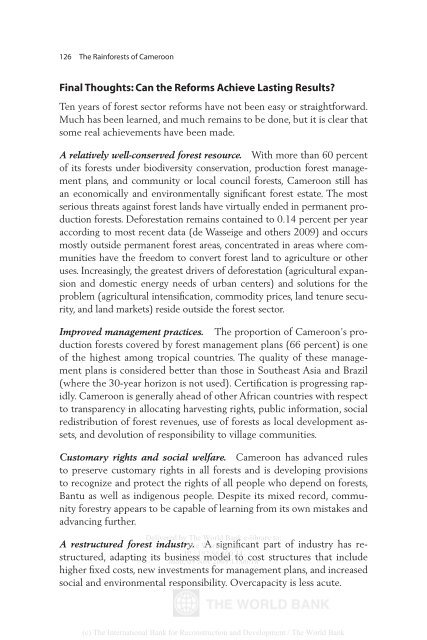The Rainforests of Cameroon - PROFOR
The Rainforests of Cameroon - PROFOR
The Rainforests of Cameroon - PROFOR
- No tags were found...
Create successful ePaper yourself
Turn your PDF publications into a flip-book with our unique Google optimized e-Paper software.
126 <strong>The</strong> <strong>Rainforests</strong> <strong>of</strong> <strong>Cameroon</strong>Final Thoughts: Can the Reforms Achieve Lasting Results?Ten years <strong>of</strong> forest sector reforms have not been easy or straightforward.Much has been learned, and much remains to be done, but it is clear thatsome real achievements have been made.A relatively well-conserved forest resource. With more than 60 percent<strong>of</strong> its forests under biodiversity conservation, production forest managementplans, and community or local council forests, <strong>Cameroon</strong> still hasan economically and environmentally significant forest estate. <strong>The</strong> mostserious threats against forest lands have virtually ended in permanent productionforests. Deforestation remains contained to 0.14 percent per yearaccording to most recent data (de Wasseige and others 2009) and occursmostly outside permanent forest areas, concentrated in areas where communitieshave the freedom to convert forest land to agriculture or otheruses. Increasingly, the greatest drivers <strong>of</strong> deforestation (agricultural expansionand domestic energy needs <strong>of</strong> urban centers) and solutions for theproblem (agricultural intensification, commodity prices, land tenure security,and land markets) reside outside the forest sector.Improved management practices. <strong>The</strong> proportion <strong>of</strong> <strong>Cameroon</strong>’s productionforests covered by forest management plans (66 percent) is one<strong>of</strong> the highest among tropical countries. <strong>The</strong> quality <strong>of</strong> these managementplans is considered better than those in Southeast Asia and Brazil(where the 30-year horizon is not used). Certification is progressing rapidly.<strong>Cameroon</strong> is generally ahead <strong>of</strong> other African countries with respectto transparency in allocating harvesting rights, public information, socialredistribution <strong>of</strong> forest revenues, use <strong>of</strong> forests as local development assets,and devolution <strong>of</strong> responsibility to village communities.Customary rights and social welfare. <strong>Cameroon</strong> has advanced rulesto preserve customary rights in all forests and is developing provisionsto recognize and protect the rights <strong>of</strong> all people who depend on forests,Bantu as well as indigenous people. Despite its mixed record, communityforestry appears to be capable <strong>of</strong> learning from its own mistakes andadvancing further.Delivered by <strong>The</strong> World Bank e-library to:A restructured forest industry. <strong>The</strong> World A significant Bank part <strong>of</strong> industry has restructured,adapting its business Mon, 09 Nov model 2009 17:06:18 to cost structures that includeIP : 192.86.100.34higher fixed costs, new investments for management plans, and increasedsocial and environmental responsibility. Overcapacity is less acute.(c) <strong>The</strong> International Bank for Reconstruction and Development / <strong>The</strong> World Bank
















